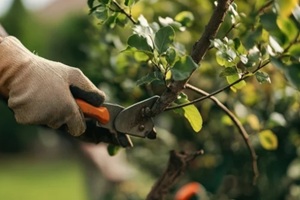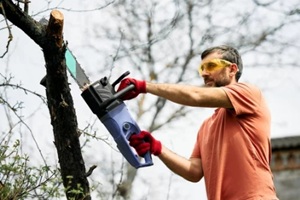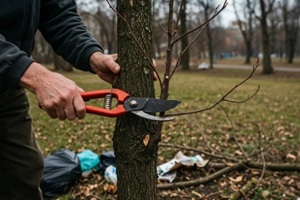
Trees are living elements of nature that provide environmental benefits for decades. However, in residential and commercial settings, as investments that enhance enjoyment and property value, they need consistent maintenance such as pruning to remain healthy and secure.
Identifying the right time for professional tree pruning can help avoid expensive damage and safeguard both your landscape and property.
This guide will assist you in recognizing the warning signs that suggest you need to seek the help of professional arborists.
Understanding Tree Pruning Signals
Professional tree pruning goes beyond simple aesthetics or cutting dead branches. It is a practice focused on preservation that enhances long-term tree health while also addressing safety issues. By knowing what to look for, you’ll be better prepared to choose the right care for your trees.
Dead or Dying Branches
The most obvious sign that tree pruning is necessary is the presence of dead, dying, or diseased branches. These branches often lack foliage during growing seasons or display brown, brittle bark. Branches that are dead or dying, whether due to disease, serious insect infestations, wildlife, storms, or other types of mechanical damage, should be promptly removed to halt further decline of the tree and minimize safety risks.
Dead branches not only affect the tree’s aesthetic appeal but also act as gateways for pests and diseases that can proliferate throughout the tree. They also present considerable safety hazards, particularly in stormy conditions when they are at a higher risk of breaking and collapsing. Knowing where and when to make these cuts, which can depend on the tree species, is key.
Storm-Damaged Branches
Virginia’s weather patterns can be particularly harsh on trees. After severe weather events, check your trees for any damaged branches that may be:
- Cracked or split
- Hanging loosely
- Stripped of bark
- Bending in an unusual way
Storm-damaged branches need immediate professional care. Even branches that are only partially damaged can suddenly break, posing safety hazards to individuals and property below.
Crossing or Rubbing Branches
When branches grow into each other, they create friction that damages bark and creates wounds. Removing branches that rub together will help prevent these persistent injury sites from becoming infected. This type of structural issue often develops gradually, making regular professional assessments valuable for early detection.
Crossing branches also compete for space and resources, reducing the overall health and vigor of affected areas. Arborists can identify which branches to trim while maintaining the tree’s natural form and structural integrity.
Overly Dense Canopy

Trees with canopies so thick that sunlight can’t penetrate to inner branches often need selective pruning. Poor air circulation and light penetration can lead to increased disease susceptibility, weak interior branch development, reduced flowering and fruiting, and pest problems in humid, stagnant conditions.
Professional crown thinning removes selected branches throughout the canopy to improve air movement and light penetration while preserving the tree’s natural shape.
Branches Interfering with Structures
Safety becomes a primary concern when tree branches grow too close to power lines (never attempt DIY removal near utilities), buildings and rooflines, driveways and walkways, or street lighting. It is imperative to bring in professional pruning services for branches that obstruct street lights, traffic signals, and other overhead wires.
This type of maintenance protects yourself and others, your property, and the community infrastructure.
Unusual Growth Patterns
Several growth patterns indicate the need for corrective pruning:
Watersprouts and Suckers: These vigorous vertical shoots often appear after stress or improper pruning. Remove vigorous vertical branches, which are called watersprouts and suckers, from the base to redirect the tree’s energy into healthy, structural growth.
Codominant Leaders: When trees develop multiple main trunks, structural weakness often results. Professional arborists can assess whether selective removal of competing leaders is appropriate.
Drooping Branches: Branches that hang low enough to obstruct pedestrian or vehicle traffic need raising through careful pruning techniques.
Signs of Pest or Disease Issues
Trees showing signs of pest infestation or disease often benefit from strategic pruning to remove affected areas before problems spread, improve air circulation that discourages fungal growth, eliminate stressed branches that attract pests, and open the canopy for better monitoring and treatment access.
Look for discolored foliage, unusual bark patterns, or signs of insect activity that may indicate the need for both pruning and pest management.
Timing Considerations for Tree Pruning
Although year-round identification is possible, timing professional intervention correctly is important for reducing stress on trees and diminishing the likelihood of disease spreading.
However, hazardous conditions require immediate attention regardless of the season. Arborists can safely address emergency situations while minimizing long-term impacts on tree health.
Benefits of Professional Assessment
Regular professional evaluations help identify pruning needs before they become serious problems. ISA-certified arborists can detect early signs of structural issues, recommend preventive pruning strategies, guarantee pruning work follows industry standards, and provide ongoing monitoring for long-term tree health. This approach helps preserve your landscape investment while maintaining safety standards that protect people and property.
RTEC Treecare: Your Partner in Professional Tree Health

If you notice any of these signs, bring in trusted, professional intervention to protect both your trees and your investment. RTEC Treecare’s ISA-certified arborists bring decades of experience to Virginia properties, combining environmental stewardship with proven tree care practices.
Our preservation-based approach means we focus on maintaining your trees’ long-term health rather than simply addressing immediate concerns. This philosophy has helped homeowners in Virginia protect their landscape investments since 1996.
Our team will provide personalized recommendations designed to address the specific requirements of your property, guaranteeing that your trees remain healthy, safe, and aesthetically pleasing for years to come.
Don’t let minor issues turn into costly emergencies. Contact RTEC Treecare online or call (571) 604-5477 to arrange an evaluation of the pruning requirements of your trees.


